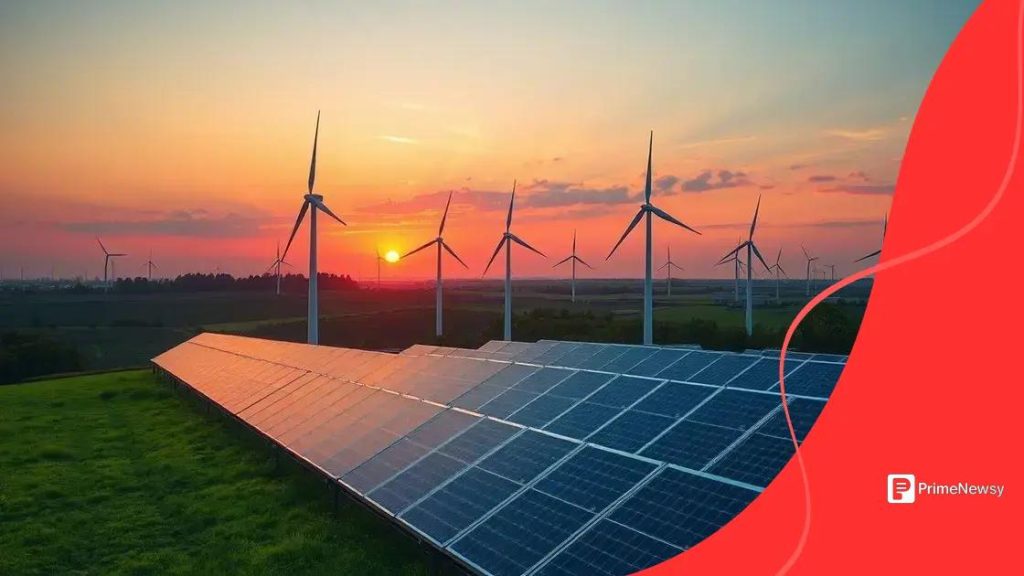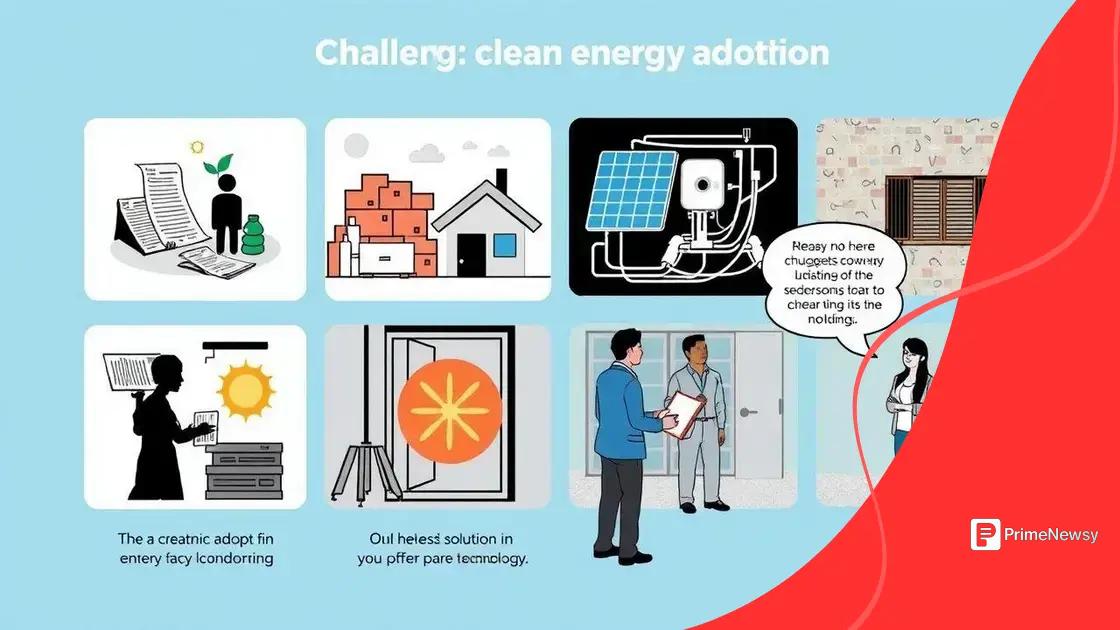Clean energy transition progress: what you should know

Anúncios
The clean energy transition involves the adoption of renewable energy sources like solar and wind, driven by technological advancements, supportive policies, and active community engagement, addressing both environmental sustainability and energy security.
Clean energy transition progress is essential for a sustainable future. As the world grapples with climate change, understanding this shift can empower us all to contribute to a greener planet. Have you considered how these changes impact your daily life?
Anúncios
Current state of clean energy transition
The current state of clean energy transition is an exciting topic as more nations commit to reducing their carbon footprints. With advancements in technology, transitioning to clean energy is becoming more attainable. This shift is crucial for both environmental sustainability and energy security.
Global Progress in Clean Energy
Around the world, countries are prioritizing renewable energy sources. Wind and solar are leading the charge, providing cleaner alternatives to fossil fuels.
- Investment in renewable infrastructure is increasing.
- Many countries have set ambitious goals for reducing greenhouse gas emissions.
- Government incentives support the growth of clean energy industries.
- Public awareness about climate change drives demand for sustainable solutions.
As we navigate the clean energy transition, it’s essential to recognize the various ways this change is being implemented. Innovative projects are popping up globally, showcasing successful models of clean energy adoption. Cities are now integrating green technologies into their planning, enhancing their resilience against climate impacts.
Anúncios
Technological Innovations
Technological innovations play a significant role in this transition. Tools for energy storage, smart grids, and efficient energy management systems are being developed rapidly. These technologies ensure that clean energy sources can reliably meet demand, moving away from the traditional reliance on coal and gas.
As we embrace these changes, we also face challenges. Some of these challenges include regulatory hurdles and the need for skilled labor to manage new technologies. Overcoming these obstacles will be key to achieving lasting progress in the clean energy sector.
In summary, the current state of clean energy transition reflects a significant global shift towards sustainability. A combination of technological innovation and increasing public and governmental support is facilitating this necessary transformation.
Technological innovations in renewable energy
Technological innovations in renewable energy have revolutionized how we harness natural resources. From solar panels to wind turbines, new advancements are being developed at a rapid pace, making clean energy more accessible and efficient.
Advancements in Solar Technology
Recent developments in solar technology have improved energy efficiency significantly. For example, perovskite solar cells are emerging as a game-changer. They are cheaper to produce and have higher absorption rates than traditional silicon cells.
- Flexible solar panels are becoming more popular.
- Energy storage solutions are improving, allowing for better energy use.
- Smart panels can optimize energy production.
- Solar farms are expanding, generating more power than ever.
In addition to solar technology, wind energy has also seen exceptional innovations. Modern wind turbines are taller and more efficient, allowing them to capture wind energy even in low-wind areas. This advancement enables more places to utilize wind energy regardless of typical wind patterns.
The Rise of Smart Grids
Another critical area of innovation is the development of smart grids. These systems enhance the distribution of electricity from renewable sources. By using advanced sensors and automation, smart grids can manage energy flow more effectively, stabilize the grid, and reduce energy waste.
Moreover, energy management systems integrated with artificial intelligence help consumers monitor and optimize their energy use. These systems provide real-time insights into energy consumption, allowing users to make educated decisions. For example, they can schedule energy-intensive tasks during off-peak hours, minimizing costs.
In the marine energy sector, new technologies are being explored to harness wave and tidal energy. These innovations promise to further diversify our renewable energy sources and enhance overall resilience. As we continue to embrace these cutting-edge solutions, the future looks bright for the renewable energy landscape.
Challenges faced in clean energy adoption

The challenges faced in clean energy adoption are significant, yet essential to address for a sustainable future. Various barriers exist, ranging from economic to technological, all impacting the transition towards renewable sources.
Financial Barriers
One major challenge is the high upfront cost of renewable energy technologies. While prices are decreasing, initial investments can still be substantial. Many businesses and households struggle to afford the installation of solar panels or wind turbines. Additionally, without government support or incentive programs, this transition can seem less viable.
- Funding options may be limited for small businesses.
- Long-term savings do not always offset initial costs.
- Financing can be confusing and hard to access.
Another financial obstacle is the perceived risk associated with renewable energy investments. Investors may be hesitant, preferring to stick with traditional energy sources where they feel more secure. This reluctance can slow down overall progress.
Technological Limitations
Technological limitations also pose challenges. For instance, energy storage solutions are crucial for the effective use of intermittent energy sources like wind and solar. Although technology is advancing, many options still suffer from inadequate efficiency or high costs.
Besides storage, integrating renewable energy sources into existing grids can be complex. Many current infrastructures are designed for fossil fuels and require significant upgrades to accommodate renewable inputs. Consequently, transitioning can take time and extensive planning.
Public awareness is yet another barrier. Many people still lack understanding about the benefits and availability of clean energy technologies. Education and outreach are needed to engage communities in the transition process.
Additionally, regulatory hurdles often hinder progress. Policies that encourage renewable energy development can vary significantly between regions. This inconsistency makes it difficult for companies to navigate the market effectively. Addressing these regulatory challenges is vital for encouraging wider adoption of clean energy solutions.
The role of policies in accelerating progress
The role of policies in accelerating progress towards clean energy is crucial. Government initiatives can significantly influence the speed and effectiveness of the transition to renewable energy sources.
Incentives for Renewable Energy
Effective policies often include incentives that encourage both businesses and individuals to invest in clean energy technologies. These incentives can come in various forms, such as tax credits, grants, and rebates. For example, tax credits for solar panel installation can make it more affordable for homeowners to switch to renewable energy.
- Financial incentives can lower initial costs.
- Subsidies help compete against fossil fuel prices.
- Grants can support research and development of new technologies.
Moreover, policies that mandate renewable energy portfolios require utilities to obtain a certain percentage of their energy from renewable sources. These mandates increase demand and drive innovation in the sector.
Regulatory Frameworks
A strong regulatory framework is essential for supporting the renewable energy market. Clear regulations help streamline the process for installing and managing renewable energy systems. This includes simplifying permitting processes and ensuring grid access for renewable energy producers. When guidelines are clear, energy companies can plan and invest with confidence, which helps in expanding renewable capacity.
Additionally, governments play a key role in research funding. By investing in research and development, authorities can help new technologies emerge that improve efficiency in renewable energy systems. Such advancements can change the landscape of energy production, making clean alternatives more viable.
Lastly, public policies can enhance education and awareness about renewable energy. Educational campaigns can inform citizens of their options and the benefits of transitioning to clean energy. When the public is aware and engaged, it creates a supportive environment for policies aimed at accelerating the transition.
Future outlook for clean energy initiatives
The future outlook for clean energy initiatives appears promising as advancements in technology and increasing global support drive the transition toward sustainability. Many countries are setting ambitious targets for renewable energy adoption, indicating a significant shift in energy policies worldwide.
Emerging Technologies
New technologies are constantly emerging that can enhance the efficiency of renewable energy systems. Innovations in battery storage are particularly exciting. Improved storage solutions will allow for better management of energy supply and demand, making renewable sources more reliable.
- Solid-state batteries are set to revolutionize energy storage.
- Advancements in grid technology will facilitate renewable integration.
- Carbon capture technology is becoming more efficient.
These advancements promise to reduce dependence on fossil fuels and help meet global energy needs in a cleaner way.
Global Collaboration
The future of clean energy will also rely on international collaboration. Countries are increasingly sharing knowledge, resources, and best practices to expedite progress. Collaborations in research and development are essential for overcoming common challenges in adopting renewables.
Global agreements, like the Paris Agreement, create frameworks that encourage nations to commit to cleaner energy goals. With nations working together, there is potential for faster advancements and broader implementation of renewable technologies.
Furthermore, communities play a vital role in driving change by embracing local renewable projects. Grassroots initiatives are vital in advocating for clean energy solutions, pushing for policy changes, and raising awareness.
As awareness grows, more individuals and businesses will look to adopt renewable energy, contributing to a cleaner environment and sustainable future. With both technological progress and collaboration, clean energy initiatives are poised to thrive in the coming years.
In conclusion, the transition to clean energy is not just a necessity but an opportunity for a sustainable future. As we embrace new technologies and foster global cooperation, we can overcome the challenges facing this vital movement. With strong policies and active community involvement, we are on the path to achieving a greener world. Everyone has a role to play in this journey, whether through adopting renewable energy solutions or supporting initiatives that promote sustainability. Together, we can help make a lasting impact and contribute to a healthier planet.
FAQ – Frequently Asked Questions about Clean Energy Initiatives
What are clean energy initiatives?
Clean energy initiatives are programs and policies aimed at promoting the use of renewable energy sources like solar, wind, and hydroelectric power.
How do policies support clean energy adoption?
Policies provide incentives, grants, and regulations that encourage businesses and individuals to invest in and adopt renewable energy technologies.
What challenges do clean energy initiatives face?
Challenges include financial barriers, technological limitations, and regulatory hurdles that can slow down the transition to clean energy.
How can communities contribute to clean energy efforts?
Communities can engage in local renewable energy projects, advocate for supportive policies, and promote awareness of clean energy benefits.